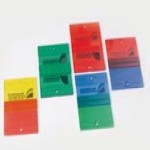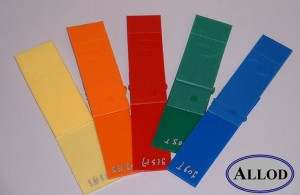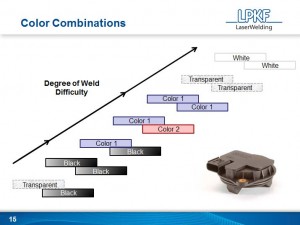
If you are familiar with laser plastic welding you understand that the upper layer needs to be transparent to the radiation and the lower layer absorbent to the same radiation.
The majority of thermoplastics transmit common laser welding wavelengths in their natural state, but a variety of factors influence the level of transmittance, including: thickness of the plastic, fillers (glass or fiber), flame retardants and color additives.
This article will focus specifically on how color affects the process.
Anytime colors or pigments are added to thermoplastics their transmission properties will change. Depending on the color additive used and in what combination will affect the difficulty of the welding process.
The chart below, taken from the Laser Plastic Welding Design Guidelines webinar, is a simple display of color combinations and the degree of difficulty introduced on the welding process. Let’s go through this chart.
Starting from the bottom we will work our way up.
Transparent to Black – the easiest combination. The natural upper layer has no color additives allowing for excellent transmissivity; the lower is most commonly doped with carbon black, an excellent absorbing pigmentation.
Black to Black – this truly displays the flexibility of color combinations. The lower layer, like number one above, is still doped with carbon black, however, the upper layer makes use of very dark red and green dies. These dies give the optical characteristics of black, while still allowing the laser to pass directly through. There is a major difference between how our eyes view the plastic and how it is “seen” by the laser.
Color to Black – this is slightly more difficult, and very dependent on the color additive used. A variety of color additives are on the market that allow good transmission, however, they will always add some degree of absorption.
Color 1 to Color 2 – without question darker colors will absorb more than lighter. By switching the black lower layer out for a color you will likely reduce your absorption rate.
 Color 1 to Color 1 – this is mostly more difficult as two separate additives that have the same optical appearance will have to have differing absorption/transmission characteristics. These combinations do exist, but again you will be adding some limitations.
Color 1 to Color 1 – this is mostly more difficult as two separate additives that have the same optical appearance will have to have differing absorption/transmission characteristics. These combinations do exist, but again you will be adding some limitations.
Transparent to Transparent – often refereed to as clear-to-clear, both plastics are commonly left in their most natural state. To achieve absorption a special additive must be either doped into the lower layer or applied to the surface. This coating/additive allows for optical translucency while providing absorption for the laser. This is mostly difficult due to the expense of the special additive and the application process.
- Clear-to-clear with no additives – a second method has been recently developed; using a higher wavelength laser it is possible to focus the majority of the laser energy at the interface of the two parts and achieve very good welds with no additives.
White to White – most white pigmentation contains Titanium dioxide, a highly reflective additive that makes the welding process very difficult.
A few other important notes…
100% transmission is not needed. In fact successful welds have taken place with as little as 5% transmission ratings, however, it is recommended to aim for ratings above 20%.
Although, color combinations do have on affect the difficulty of the weld process, with the vast array of additives and pigments available most desired color combinations can be achieved.
If you have specific questions on color combinations please feel free to contact the author of this article, Josh Brown.
Josh Brown
Marketing Development Representative
LPKF Laser & Electronics
503.454.4231
Other material resources:
Laser Plastic Welding Design Guidelines document
Webinar: Laser Plastic Welding Design Guidelines



